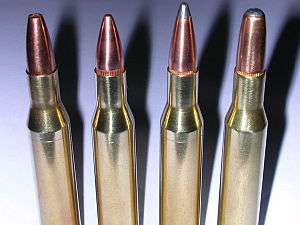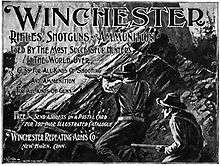.270 Winchester
The .270 Winchester is a rifle cartridge developed by Winchester Repeating Arms Company in 1923 and unveiled in 1925 as a chambering for their bolt-action Model 54.[3] The cartridge is a necked-down .30-03 Government, and is the same length as the .280 Remington, both of which are longer than the .30-06 Springfield. The .270, .280, and .30-06 were all derived from the .30-03 parent case. The .270 Winchester uses a .270 inch (6.86 mm) bore diameter and a .277 inch (7.04 mm) bullet diameter.
| .270 Winchester | ||||||||||||||||||||||||
|---|---|---|---|---|---|---|---|---|---|---|---|---|---|---|---|---|---|---|---|---|---|---|---|---|
 Left to right 130-grain (8.4 g) - hollow point, 100-grain (6.5 g) FMJBT, 130-grain (8.4 g) soft point, 160-grain (10 g) lead round nose | ||||||||||||||||||||||||
| Type | Rifle / hunting | |||||||||||||||||||||||
| Place of origin | United States | |||||||||||||||||||||||
| Production history | ||||||||||||||||||||||||
| Designer | Winchester | |||||||||||||||||||||||
| Designed | 1923 | |||||||||||||||||||||||
| Manufacturer | Winchester | |||||||||||||||||||||||
| Produced | 1925-present | |||||||||||||||||||||||
| Specifications | ||||||||||||||||||||||||
| Parent case | .30-03 Government | |||||||||||||||||||||||
| Bullet diameter | .277 in (7.0 mm) | |||||||||||||||||||||||
| Neck diameter | .308 in (7.8 mm) | |||||||||||||||||||||||
| Shoulder diameter | .441 in (11.2 mm) | |||||||||||||||||||||||
| Base diameter | .470 in (11.9 mm) | |||||||||||||||||||||||
| Rim diameter | .473 in (12.0 mm) | |||||||||||||||||||||||
| Case length | 2.540 in (64.5 mm) | |||||||||||||||||||||||
| Overall length | 3.340 in (84.8 mm) | |||||||||||||||||||||||
| Case capacity | 67 gr H2O (4.3 cm3) | |||||||||||||||||||||||
| Rifling twist | 1 in 10 in (250 mm) | |||||||||||||||||||||||
| Primer type | Large rifle | |||||||||||||||||||||||
| Maximum pressure | 65,000 psi (450 MPa) | |||||||||||||||||||||||
| Ballistic performance | ||||||||||||||||||||||||
| ||||||||||||||||||||||||
| Source(s): Norma, Hodgdon,[1] Hornady[2] | ||||||||||||||||||||||||
Description
The .270 Winchester became a very popular cartridge due to the widespread praises of gunwriters like Townsend Whelen and Jack O'Connor who used the cartridge for 40 years and touted its merits in the pages of Outdoor Life.[4][5] It drives an 8.4 grams (130 gr) bullet at approximately 960 m/s (3,140 ft/s), later reduced to 930 m/s (3,060 ft/s). The cartridge demonstrated high performance at the time of its introduction and was marketed as being suitable for big game shooting in the 270 to 460 metres (300 to 500 yd) range, when that was considered long range hunting. With modern bullets and optics, it is easily a 1,000 yard cartridge. Two additional bullet weights were soon introduced: a 6.5 grams (100 gr) hollow-point bullet for varmint shooting, and a 9.7 grams (150 gr) bullet for deer, elk, and moose in big-game hunting.[3]
While not an immediate success, over the succeeding decades and especially in the post-World War II period, the .270 Winchester attained great popularity among gun owners, metallic silhouette shooters and hunters, ranking it among the most popular and widely used cartridges worldwide. Internationally, firearms manufacturers now offer this chambering in all firearm varieties: bolt-actions, single-shots, lever-actions (such as the Browning BLR), pump-actions (such as the Remington 7600), autoloaders (such as the Remington 7400), and even a few double rifles.[6]
Loads
Cartridges are commonly available from 6.5 to 10.4 grams (100 to 160 gr) sizes with 8.4-and-9.7-gram (130 and 150 gr) loads being by far the most popular. Handloaders have a larger range of options with the availability of bullets in a number of weights from 5.8 to 11.7 grams (90 to 180 gr). Common bullet weight recommendations for shooting different game are as follows:
- 5.8–7.1 grams (90–110 gr) bullets: animals smaller than coyotes.
- 8.4 grams (130 gr) bullets: antelope or other animals up to the size of mule deer.
- 9.1–10.4 grams (140–160 gr) bullets: deer, elk, moose, and some larger animals.[1]
Recent introductions of low-drag bullets suited to the .270 Winchester such as the Nosler Accubond Long-Range, Hornady ELD-X and Matrix long range bullets are promoting renewed interest in the cartridge among long range hunters.
While it is true that a .270 Winchester case can be formed from a .30-06 Springfield case, the case length of a .30-06 is 63.3 millimetres (2.494 in) while the case length of a .270 is 64.5 millimetres (2.540 in), the same as a .30-03 Springfield. However, "The slight difference in length of reformed cases doesn't make any practical difference." [7]
See also
References
- ".270 Win data from Hodgdon". Archived from the original on 2007-11-16. Retrieved 2007-07-11.
- "Hornady Superformance commercial ammo specifications". Archived from the original on 2010-08-21. Retrieved 2010-08-03.
- The Complete Reloading Manual for the .270 Winchester, Loadbooks USA, Inc., 2004, pp.13,19
- Barnes Reloading Manual Number 2 (1997)
- Hornady Handbook of Cartridge Reloading, Fourth Edition (1996)
- Speer Reloading Manual Number 12 (1994)
- Speer Reloading Manual Number Ten (1979), p. 182
